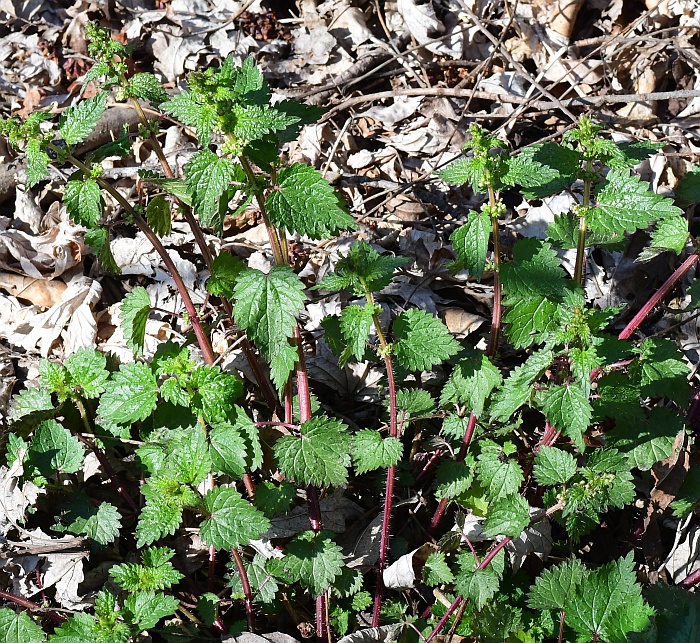Urtica chamaedryoides Pursh
Weak Nettle

Native
CC = 8
CW = 3
MOC = 9
SRank = S1
© SRTurner
Urtica chamaedryoides PurshWeak Nettle | |
 |
Native CC = 8 CW = 3 MOC = 9 SRank = S1 |
© SRTurner |
|
Family - Urticaceae Habit - Annual forb with short taproot. Stem - To 80 cm, ascending but often reclining at maturity, usually multiple from base, pubescent with scattered stinging hairs, otherwise glabrous.
Leaves - Alternate, simple, stipulate, petiolate. Blades 1-8 cm long, noticeably smaller toward the stem tip, narrowly ovate to ovate or somewhat heart-shaped, rounded to truncate or shallowly cordate at the base (those of the reduced upper leaves sometimes narrower and more or less angled at the base), the margins regularly and bluntly toothed, the surfaces sparsely to moderately short-hairy, the upper surface also with scattered stinging hairs along the main veins, the undersurface sometimes purplish-tinged; cystoliths rounded or short-linear. Stipules 1-4 mm long, oblong to narrowly oblong or linear.
Inflorescences - Small axillary globose clusters, shorter than the subtending petioles, sometimes appearing as short, dense, spikelike racemes, the staminate and pistillate flowers mixed in the same inflorescence.
Flowers - Staminate flowers with 4 sepals, these 0.8-1.5 mm long, cupped around the stamens. Stamens 4. Pistillate flowers with 4 free sepals, the 2 smaller sepals 0.4-0.8 mm long, linear, the 2 larger sepals 1.4-2.0 mm long, ovate, these loosely cupped around but not fused to the ovary and fruit. Style absent, the stigma capitate (papillose and appearing bushy, not persistent at fruiting), the stigmatic region linear. Fruits - Achenes 1.0-1.5 mm long, flattened, ovate or ovate-elliptic in outline, tan to brown, glabrous, the surface often appearing finely pebbled. Flowering - April - September Habitat - Streambanks, bottomland forests, bases of bluffs, railroads, and moist disturbed areas. Origin - Native to the U.S. Lookalikes - Urtica urens. Other info. - This easily overlooked species occurs in a few Missouri counties, mostly in the southeast and southwest corners of the state, which is close to the far northern extent of its range. More broadly it is found across portions of the southeastern quadrant of the continental U.S. In Missouri it is uncommon, and is currently classified as S1 (critically imperiled). It is identified by the easily-observed stinging hairs on the stems and leaves, and the alternate leaves, which are toothed and indented at the base. The common name "weak nettle" is descriptive, since the plant tends to recline on the ground, and the stems are easily broken. The plant demands respect, capable of inflicting stings which may be the worst among all Missouri's species of nettle. Photographs taken at Flamm City River Access, Jefferson County, MO, 3-29-2024 (SRTurner). |